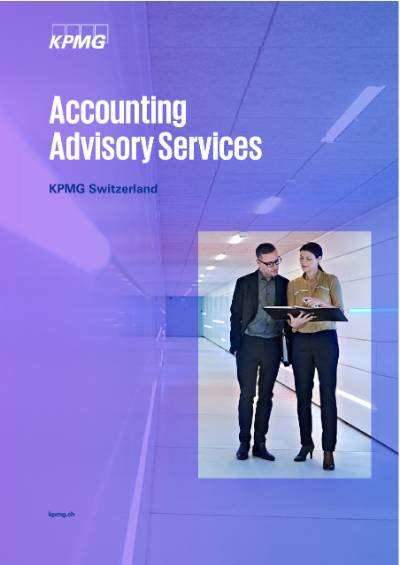KPMG's Accounting Advisory Services team is a group of committed subject matter experts with in-depth experience around complex accounting topics and understanding of your industry’s specific challenges.
At KPMG, we're more than a service provider - we're your partner for success. Our comprehensive suite of Accounting Advisory Services is designed to help your business navigate the complexities of accounting and financial reporting, driving growth and unlocking your full potential.
We can support you with our broad practical experience in transactions, in the implementation and application of national and international accounting standards and the optimization of communications with various stakeholders regarding your reporting.
Dare to transform your business's financial landscape.
Contact us for a not binding initial consultation.
Are you facing any of these situations?
- You are considering a transition to IFRS, Swiss GAAP FER or US GAAP from another financial reporting standard.
- Your company has acquired a business and you need to assess the impact of the transaction from a financial accounting perspective, assistance with asset valuations and purchase price allocation.
- Your company has decided to sell a subsidiary or part of the business and you’re seeking to understand the impacts of structuring the transaction from a financial accounting perspective, assistance preparing carve-out financial statements and support with complex technical accounting issues.
- Your company is considering becoming publicly listed and you want to obtain clarity on all relevant aspects of an IPO trajectory, the stage of your company on its way to the capital market as well as the steps required to achieve IPO readiness.
- You want to optimize and simplify your reporting process with a new consolidation software, and you are searching for a structured approach to evaluate and shortlist a consolidation solution optimally addressing specific needs of your company.
- Your company is required to prepare consolidated financial statements, but you lack personnel resources or in-house financial expertise.
- You seek assistance with compiling a meaningful and user-friendly accounting manual tailored to the individual needs and characteristics of your company or you want an independent review of your existing accounting manual.
- You are facing a complex financial accounting issue and are seeking advice from an IFRS, Swiss GAAP FER or US GAAP accounting expert or you want to obtain a second opinion.
- You are short of personnel resources and require interim support from a financial accounting and reporting specialist.
- You want to increase the knowledge of financial reporting standards within your company.
Our services
Ready to elevate your financial accounting landscape?
With a wealth of experience in complex, large-scale accounting projects, our team is uniquely positioned to assess your current situation and address your company's specific accounting challenges effectively.
Financial standard conversion
Is your business transitioning to a new “true and fair view” financial standard like IFRS , US GAAP, or Swiss GAAP FER? Our expert team provides comprehensive support, ensuring a seamless conversion of your reports and full compliance with all relevant accounting regulations.
Consolidation tool evaluation
Many consolidation and financial reporting applications are available in the market. Our consolidation tool evaluation service can support you all the way, from evaluating a suitable consolidation software for your group to helping you with administrative or technical problems once the consolidation tool has been implemented.
Learn how we can simplify your consolidation software selection process
IPO readiness assessment
Contemplating becoming a public company? Our holistic Initial Public Offering (“IPO”) readiness assessment service will navigate you through the complex IPO process, ensuring all regulatory requirements are met.
Accounting manual and policy reviews
Seeking an up-to-date, meaningful and user-friendly accounting manual that reflects all the latest accounting and reporting requirements? We can ensure your accounting records comply with the latest applicable accounting standards of IFRS, Swiss GAAP FER, or US GAAP.
Uncover the benefits of our accounting manual and policy reviews
Accounting advisory for mergers and acquisitions
Planning an acquisition, a spinoff, or a sale? Our Accounting Advisory Services provide expert guidance throughout the M&A process, ensuring a successful completion, providing post-deal advice or financial integration support.
See how our accounting advisory can facilitate your mergers & acquisitions
Financial consolidation-as-a-service
Considering full or partial outsourcing your reporting and financial consolidation processes? Our managed services model enables your company to outsource the preparation of consolidated financial statements, achieving efficiency, cost-effectiveness, and regulatory compliance.
Additional services tailored to your needs
Beyond our core services, we offer:
- Financial accounting consulting: Obtain solution-oriented advice in complex accounting matters within the scope of IFRS, Swiss GAAP FER, US GAAP or Swiss Code of Obligations.
- Technical trainings and workshops: Empower your team with our professional financial accounting trainings and workshops customised for your industry and business.
- Staff loans: Leverage the expertise of our financial accounting professionals who can join your team temporarily on-site or off-site during peak times, to bridge your transitional staff shortages, or as reinforcement for large projects.
- Second opinion: Obtain additional perspective to confirm or re-evaluate GAAP interpretations on complex accounting matters within the scope of IFRS, Swiss GAAP FER, US GAAP or Swiss Code of Obligations.
Stay in touch
We closely follow developments in different accounting principles and will keep you informed on the specific impact these changes will have on the reporting for your company.
Sign up for our quarterly IFRS newsletter or stay informed about regular professional events, which provide you with further insights.








